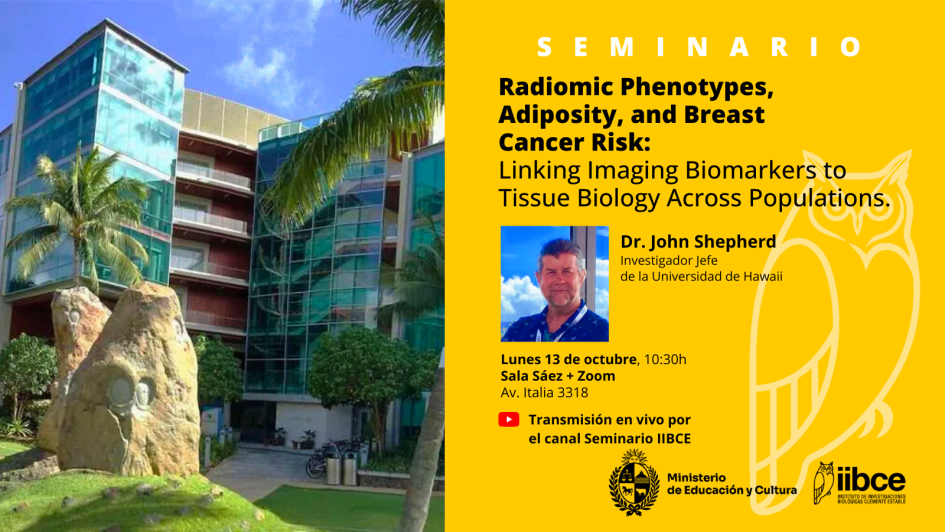Seminario IIBCE 13/10/25 - 10:30 h
Les invitamos al próximo encuentro del Seminario IIBCE el lunes 13 de octubre a las 10:30 en modalidad híbrida, en la Sala Sáez del Instituto Clemente Estable (Avenida Italia 3318) y vía Zoom.
- 10:30
- Instituto de Investigaciones Biológicas Clemente Estable
Presentará el Dr.John Shepherd, investigador Jefe de la Universidad de Hawaii:
Radiomic Phenotypes, Adiposity, and Breast Cancer Risk: Linking Imaging Biomarkers to Tissue Biology Across Populations
Enlace a la reunión de Zoom
https://us06web.zoom.us/j/88517482472?pwd=kw8YMtk8nTqxWwjWOmjXmt6babCADT.1
ID de reunión: 885 1748 2472
Código de acceso: 434754
También pueden seguir la conferencia en directo a través del Canal Seminario IIBCE.
Atención: este Seminario ocurrirá en un día, horario y lugar fuera de lo habitual: Lunes 13/10 en la sala Sáez del instituto
Resumen
Radiomic analysis of breast imaging is opening new avenues to understand how tissue composition and microenvironmental biology contribute to cancer risk. Through our NCI-funded Breast SPORE project, we are investigating how AI-derived imaging phenotypes from 2D and 3D mammography relate to breast cancer risk and tissue characteristics among Native Hawaiian, Japanese, Filipina American, and White women. Our first aim evaluates how established radiomic features, including parenchymal texture and density measures, improve risk prediction models by molecular subtype and race/ethnicity in a cohort of nearly half a million screening visits. The second aim examines how these radiomic signatures correlate with tissue protein biomarkers—such as α-SMA, CD36, CD68, and CD8—and gene expression patterns measured by the NanoString Breast 360 panel, illuminating imaging correlates of the tumor microenvironment. Finally, we assess how visceral adiposity, reflected by validated biomarker scores, modifies the relationship between radiomic features and postmenopausal breast cancer risk. Together, these studies link non-invasive imaging phenotypes to tissue biology and population-specific pathways of breast cancer risk and progression.
Bio: Dr. Shepherd is the Chief Scientific Officer of the University of Hawaii Cancer Center and the B.H. and Alice C. Beams Endowed Professor in Cancer Research at the John A Burns School of Medicine. He is also a Fulbright Scholar, a Fellow of the American Institute for Medical and Biological Engineering (AIMBE), a fellow of the American Association of Physicists in Medicine (AAPM), and a former President of the International Society for Clinical Densitometry. He received his PhD in Engineering Physics from the University of Virginia and then completed a Postdoctoral Fellowship in Biophysics at Princeton University. From there he went on to develop body composition and bone density algorithms for a major women’s health company and his patents are the basis for the accuracy of that company’s body composition algorithms. He then joined the Radiology Department of the University of California San Francisco and led his research group for 19 years studying a wide variety of imaging biomarkers for breast cancer, obesity, and osteoporosis using advanced machine-learning techniques. For the past 7 years, he has been with the University of Hawaii Cancer Center where is the Director of the Hawaii Pacific Islands Mammography Registry which is currently monitoring over 125k women for developing breast cancer risk models in this population with high disparity and underrepresentation. He also co-host the biennial International Breast Density and Risk Assessment Workshops with the next workshop to be held in Lihue on the Island of Kauai in June, 2025. He has been continuously funded by the NIH since 2005, led 6 R01-funded studies, and published over 350 peer-reviewed publications. Lastly, he is an avid surfer, cyclist, and island ridge hiker!

